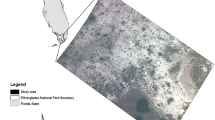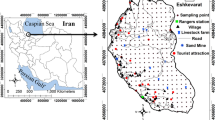Abstract
The main objective of this study was to fit and recognize spatial distribution patterns of grassland insects using various neural networks, and to analyze the feasibility of neural networks for detecting spatial distribution patterns of grassland insects. BP neural network, Learning vector quantization (LVQ) neural network, linear neural network and Fisher’s linear discriminant analysis were used to fit and recognize spatial distribution patterns at different ecological scales. Various comparisons and analysis were conducted. The results showed that BP, LVQ and linear neural networks were better algorithms for recognizing spatial distribution patterns of grassland insects. BP neural network was the best algorithm to fit spatial distribution patterns. BP network may be used to recognize the spatial details of distribution patterns, and the recognition performance of BP network became better as the increase of the number of hidden layers and neurons. Performance of linear neural network for pattern recognition was similar to linear discrimination method. Linear neural network would yield better performance in finding the general trends of distribution patterns. Recognition performance of LVQ network was just between BP network and linear network. It was found that recognition performance of neural networks depended upon not only the ecological scale but also the criterion for classification. Under the uniform criterion, recognition efficiency of linear methods tended to be weak as ecological scale became to be coarser. A joint use of neural networks was suggested in order to achieve both overall and detailed understanding on spatial distribution patterns.





Similar content being viewed by others
References
Abrahart RJ, White SM (2001) Modelling sediment transfer in Malawi: comparing backpropagation neural network solutions against a multiple linear regression benchmark using small data set. Phys Chem Earth (B) 26(1):19–24
Acharya C, Mohanty S, Sukla LB, Misra VN (2006) Prediction of sulphur removal with Acidithiobacillus sp. using artificial neural networks. Ecol Modell 190(1–2):223–230
Almasri MN, Kaluarachchi JJ (2005) Modular neural networks to predict the nitrate distribution in ground water using the on-ground nitrogen loading and recharge data. Environ Modell Softw 20:851–871
Brosse S, Guegan JF, Tourenq JN et al (1999) The use of artificial neural networks to assess fish abundance and spatial occupancy in the littoral zone of a mesotrophic lake. Ecol Modell 120:299–311
Brown KS Jr (1991) Conservation of neotropical insects: insects as indicators. In: Collins NM, Thomas JA (eds) The conservation of insects and their habitats. Academic, London, pp 349–404
Cereghino R, Giraudel JL, Compin A (2001) Spatial analysis of stream invertebrates distribution in the Adour–Garonne drainage basin (France), using Kohonen self organizing maps. Ecol Modell 146:167–180
Chon TS, Park YS, Moon KH et al (1996) Patternizing communities by using an artificial neural network. Ecol Modell 90:69–78
Dawson CW, Abrahart RJ, Shamseldin AY et al (2006) Flood estimation at ungauged sites using artificial neural networks. J Hydrol 319:391–409
Feis (2003) Analysis and design of neural networks in MATLAB 6.5, Electronics Industry Press, Beijing
Filippi AM, Jensen JR (2006) Fuzzy learning vector quantization for hyperspectral coastal vegetation classification. Remote Sens Environ 100:512–530
Hagan MT, Demuth HB, Beale MH (1996) Neural network design. PWS Publishing Company, USA
Kohonen T (1990) The self-organizing map. Proc IEEE 78:1464–1480
Krebs CJ (1989) Ecological methodology. HarperCollins, New York
Kremen C, Colwell RK, Erwin TL, Murphy DD (1993) Invertebrate assemblages: their use as indicators in conservation planning. Conserv Biol 7:796–808
Lek S, Delacoste M, Baran P et al (1996) Application of neural networks to modelling non-linear relationships in ecology. Ecol Modell 90:39–52
Maravelias CD, Haralabous J, Papaconstantinou C (2003) Predicting demersal fish species distributions in the Mediterranean Sea using artificial neural networks. Mar Ecol Prog Ser 255:249–258
Marchant JA, Onyango CM (2003) Comparison of a Bayesian classifier with a multilayer feed-forward neural network using the example of plant/weed/soil discrimination. Comput Electron Agric 39:3–22
Mathworks (2002) Neural network toolbox, MATLAB 6.5
Moshou D, Vrindts E, Ketelaere BD (2001) A neural network based plant classifier. Comput Electron Agric 31:5–16
Nagendra SMS, Khare M (2006) Artificial neural network approach for modelling nitrogen dioxide dispersion from vehicular exhaust emissions. Ecol Modell 190(1–2):99–115
Olden JD, Joy MK, Death RG (2004) An accurate comparison of methods for quantifying variable importance in artificial neural networks using simulated data. Ecol Modell 178:389–397
Paruelo JM, Tomasel F (1997) Prediction of functional characteristics of ecosystems: a comparison of artificial neural networks and regression models. Ecol Modell 98:173–186
Schultz A, Wieland R (1997) The use of neural networks in agroecologica modeling. Comput Electron Agric 18:73–90
Shao J, Xin H, Harmon JD (1998) Comparison of image feature extraction for classification of swine thermal comfort behavior. Comput Electron Agric 19:223–232
Smith DW, El-Din MG, Prepas EE (2006) The application of artificial neural networks to flow and phosphorus dynamics in small streams on the Boreal Plain, with emphasis on the role of wetlands. Ecol Modell 191(1):19–32
SPSS Inc., SPSS for Windows 11.0.0, 2001
Yan PF, Zhang CS (2000) Artificial neural networks and simulated evolution. Tsinghua University Press, Beijing
Yu R, Leung PS, Bienfang P (2006) Predicting shrimp growth: artificial neural network versus non-linear regression models. Aquac Eng 34:26–32
Zhang WJ, Qi YH (2002) Functional link artificial neural network and agri-biodiversity analysis. Biodivers Sci 3:345–350
Zhang WJ, Barrion AT (2006) Function approximation and documentation of sampling data using artificial neural networks. Environ Monit Assess 122(1–3):185–201
Zhang WJ (2007a) Supervised neural network recognition of habitat zones of rice invertebrates. Stochastic Environ Res Risk Assess (in press)
Zhang WJ (2007b) Pattern classification and recognition of invertebrate functional groups using self-organizing neural networks. Environ Monit Assess (in press)
Zhang WJ, Bai CJ, Liu GD (2007) Neural network modeling of ecosystems: a case study on cabbage growth system. Ecol Modell 201:317–325
Acknowledgments
This research was granted by “973” program of China (2006CB102005), and “948” program of China (2006-G32). We thank all participants of insects investigation, Mr. WG Zhou, HQ Dai, and undergraduates of ecological science, Zhongshan University, China.
Author information
Authors and Affiliations
Corresponding author
Rights and permissions
About this article
Cite this article
Zhang, W., Zhong, X. & Liu, G. Recognizing spatial distribution patterns of grassland insects: neural network approaches. Stoch Environ Res Risk Assess 22, 207–216 (2008). https://doi.org/10.1007/s00477-007-0108-3
Published:
Issue Date:
DOI: https://doi.org/10.1007/s00477-007-0108-3




